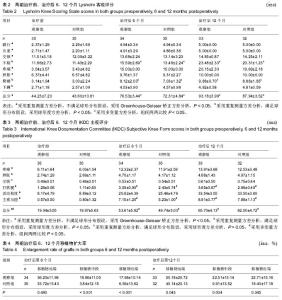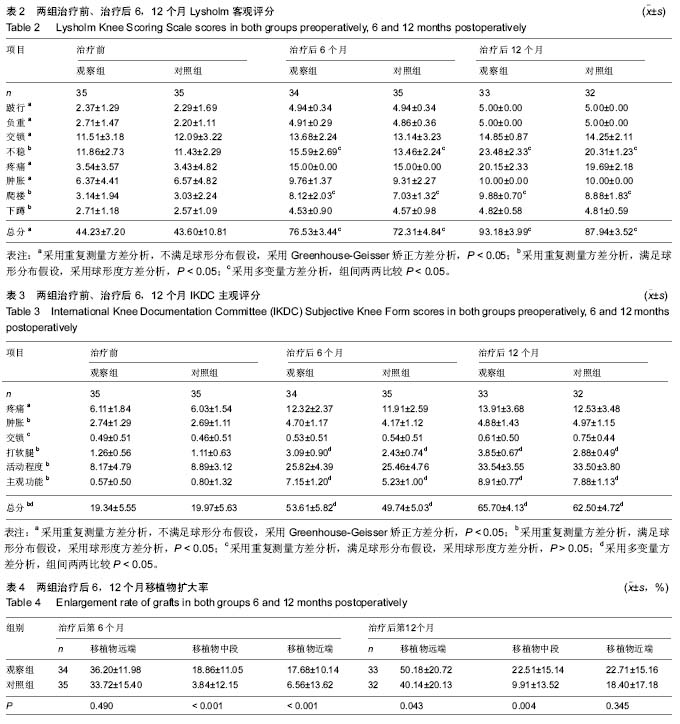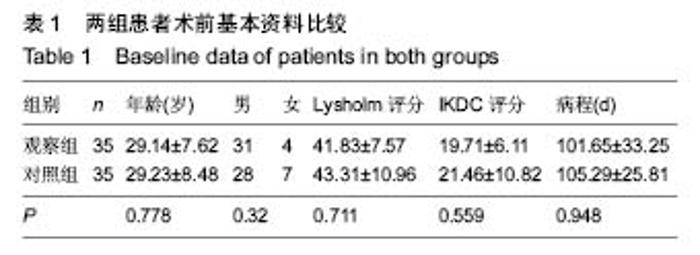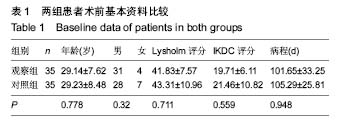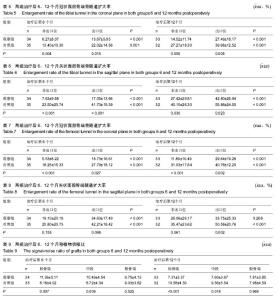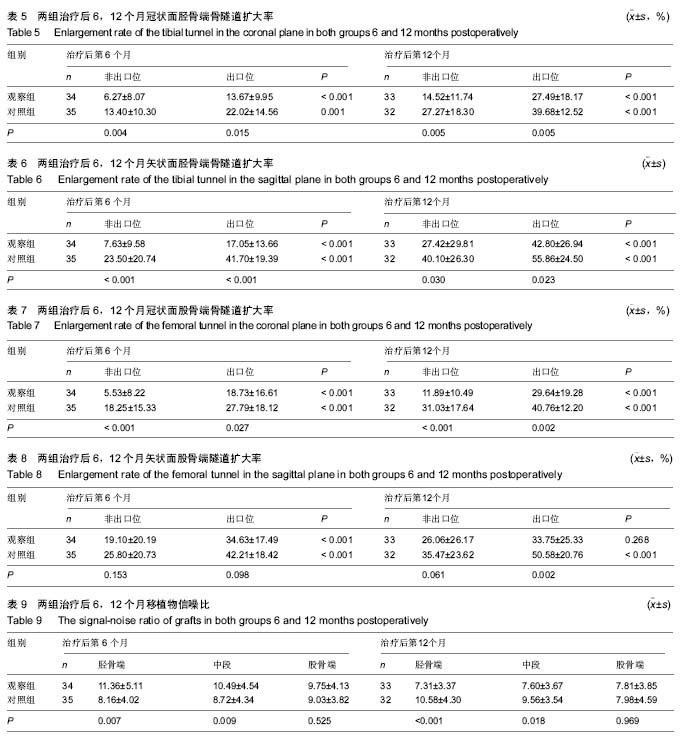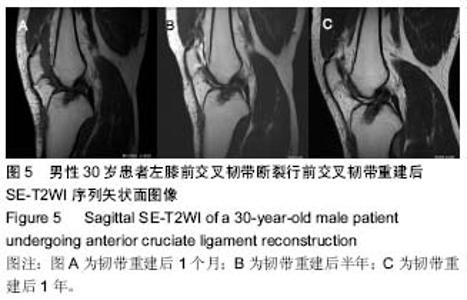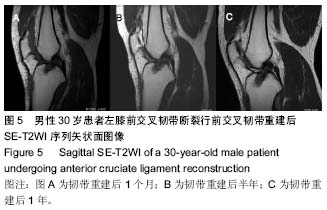| [1] Yasuda K,Tanabe Y,Kondo E,et al.Anatomic double-bundle anterior cruciate ligament reconstruction. Arthroscopy. 2010; 26(9 Suppl):S21-S34.[2] Ardern CL,Taylor NF,Feller JA, et al.Return-to-sport outcomes at 2 to 7 years after anterior cruciate ligament reconstruction surgery.Am J Sports Med.2012;40(1):41-48.[3] Muller B,Bowman KJ,Bedi A.ACL graft healing and biologics. Clin Sports Med.2013;32(1):93-109.[4] 王俊良.BMP-2和HGF基因修饰的自体MSCs促进腱骨愈合的研究[D].军医进修学院解放军总医院 军医进修学院,2012.[5] Bi F, Shi Z, Liu A, et al.Anterior cruciate ligament reconstruction in a rabbit model using silk-collagen scaffold and comparison with autograft.PLoS One.2015;10(5):e125900.[6] Dong S, Huangfu X, Xie G, et al. Decellularized Versus Fresh-Frozen Allografts in Anterior Cruciate Ligament Reconstruction: An In Vitro Study in a Rabbit Model. Am J Sports Med.2015;43(8):1924-1934.[7] Jang KM, Lim HC, Jung WY, et al.Efficacy and Safety of Human Umbilical Cord Blood-Derived Mesenchymal Stem Cells in Anterior Cruciate Ligament Reconstruction of a Rabbit Model: New Strategy to Enhance Tendon Graft Healing. Arthroscopy.2015;31(8):1530-1539.[8] 杨伟毅,陈嘉怡,何於,等.补肾中药对兔前交叉韧带重建后腱-骨愈合生物力学的影响[J]. 广东医学,2014,35(13): 2001-2003.[9] 周义钦,吴海山.膝关节本体感觉与交叉韧带机械感受器的研究进展[J].骨科,2013,4(2):102-105, 109[10] Relph N, Herrington L, Tyson S. The effects of ACL injury on knee proprioception: a meta-analysis. Physiotherapy. 2014; 100(3):187-195[11] Ageberg E, Friden T. Normalized motor function but impaired sensory function after unilateral non-reconstructed ACL injury: patients compared with uninjured controls. Knee Surg Sports Traumatol Arthrosc.2008;16(5):449-456[12] Gokeler A, Benjaminse A, Hewett T E, et al. Proprioceptive deficits after ACL injury: are they clinically relevant?. Br J Sports Med,2012,46(3):180-192.[13] Krogsgaard MR,Fischer-Rasmussen T,Dyhre-Poulsen P.Absence of sensory function in the reconstructed anterior cruciate ligament.J Electromyogr Kinesiol.2011;21(1):82-86.[14] Hong L,Li X,Zhang H,et al.Anterior cruciate ligament reconstruction with remnant preservation: a prospective, randomized controlled study.Am J Sports Med.2012;40(12): 2747-2755.[15] 朱渊,徐向阳,刘津浩,等. 踝关节镜下微骨折手术治疗距骨骨软骨损伤[J]. 第三军医大学学报,2015,37(3): 211-214.[16] 杨伟毅, 潘建科, 谢辉,等.补肾中药促进兔前交叉韧带重建术后腱-骨愈合的组织学观察. 世界中西医结合杂志,2016,11(5): 636-639.[17] 杨伟毅,陈嘉怡,何於,等.补肾中药对兔前交叉韧带重建术后腱-骨愈合生物力学的影响.广东医学,2014,351(3):2001-2003.[18] 王喜军,孙文军,张宁,等.六味地黄丸血中移行成分的分离及结构鉴定[J].中国天然药物,2007,5(4):277-280.[19] 龚圆渊,张力华.六味地黄丸诱导大鼠骨髓间充质干细胞向神经元样细胞分化的研究[J]. 辽宁中医药大学学报,2014,16(10):37-40.[20] 齐勇,李晓燕,李东卿,等.骨髓基质干细胞移植促进兔交叉韧带损伤愈合的研究[J]. 中华损伤与修复杂志:电子版,2012,07(1):12-17.[21] 高丽,白赟,王永辉,等.六味地黄丸含药血清对骨髓细胞增殖的影响[J]. 时珍国医国药,2012,23(7):1598-1599.[22] 程志安,韩凌,危建安,等.六味地黄丸、金匮肾气丸及健骨二仙丸含药血清对BMSCs成脂、成骨细胞分化相关基因的影响[J].中国中西医结合杂志,2013,33(2):261-265.[23] 孙晖,张宁,李丽静,等.六味地黄丸主要血中移行成分对培养大鼠成骨细胞促增殖作用的研究[J]. 中国中药杂志,2008;33(17): 2161-2164.[24] 刘淑仪,潘建科,刘军,等. 前交叉韧带损伤影像学研究进展[J]. 放射学实践,2016,31(9):893~895.[25] Li H,Tao H,Cho S,et al.Difference in graft maturity of the reconstructed anterior cruciate ligament 2 years postoperatively: a comparison between autografts and allografts in young men using clinical and 3.0-T magnetic resonance imaging evaluation.Am J Sports Med.2012; 40(7): 1519-1526.[26] Yang X, Li M, Chen D, et, al. Diffusion tensor imaging for anatomical and quantitative evaluation of the anterior cruciate ligament and ACL grafts: a preliminary study. J Comput Assist Tomogr. 2014;38(4):489-494.[27] Delin C, Silvera S, Coste J, et, al. Reliability and diagnostic accuracy of qualitative evaluation of diffusion-weighted MRI combined with conventional MRI in differentiating between complete and partial anterior cruciate ligament tears. European radiology.2013;23(3):845-854.[28] 陈立勋,赵衡,李劲松,等. 健康人前交叉韧带的扩散张量成像及其与MRI的比较[J]. 中南大学学报(医学版), 2013,06:610-616.[29] Hooijmans MT, Damon BM, Froeling M, et al. Evaluation of skeletal muscle DTI in patients with duchenne muscular dystrophy. Nmr in Biomedicine.2015;28(11):1589–1597.[30] Raya JG, Gerd M, Silvia AN, et al. Diffusion-tensor imaging of human articular cartilage specimens with early signs of cartilage damage. Radiology.2013;266(3):831-841.[31] Jaana H, Taru S, Sakari A, et al. Diffusion tensor imaging and tractography of distal peripheral nerves at 3 T. Clinical Neurophysiology Official Journal of the International Federation of Clinical Neurophysiology.2005;116(10): 2315-2323. |
